

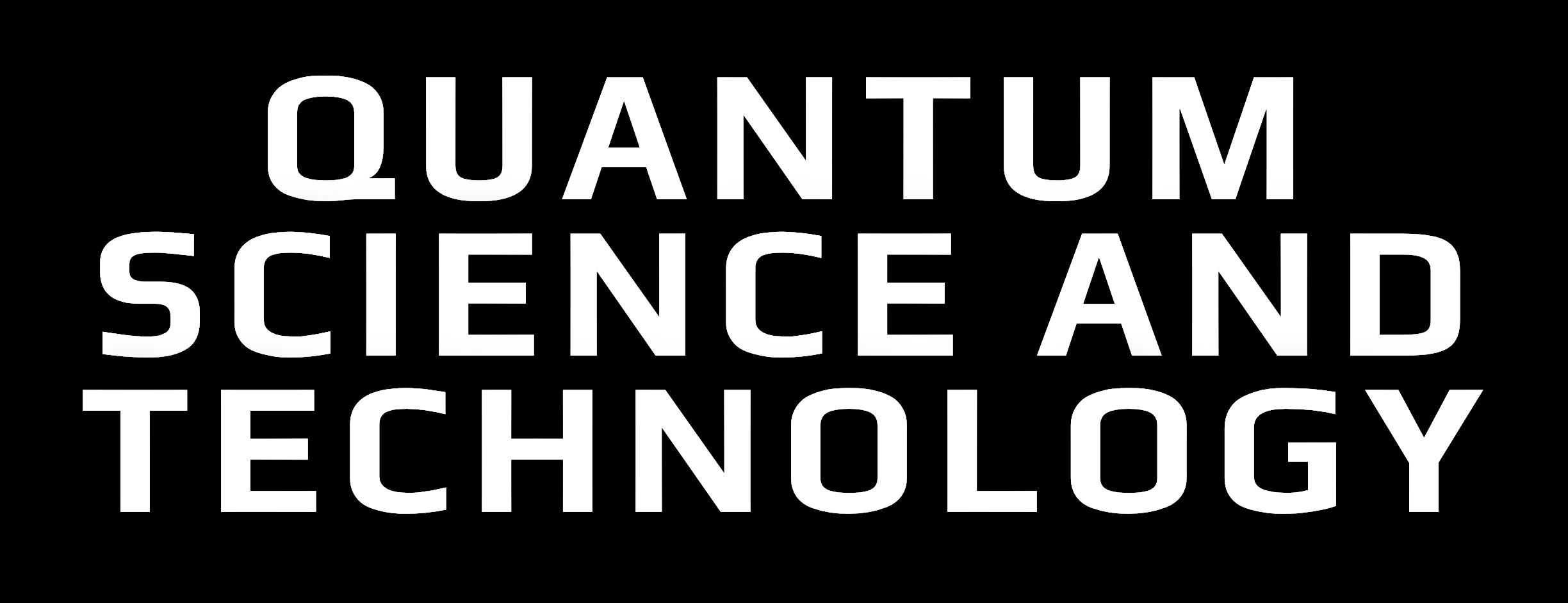

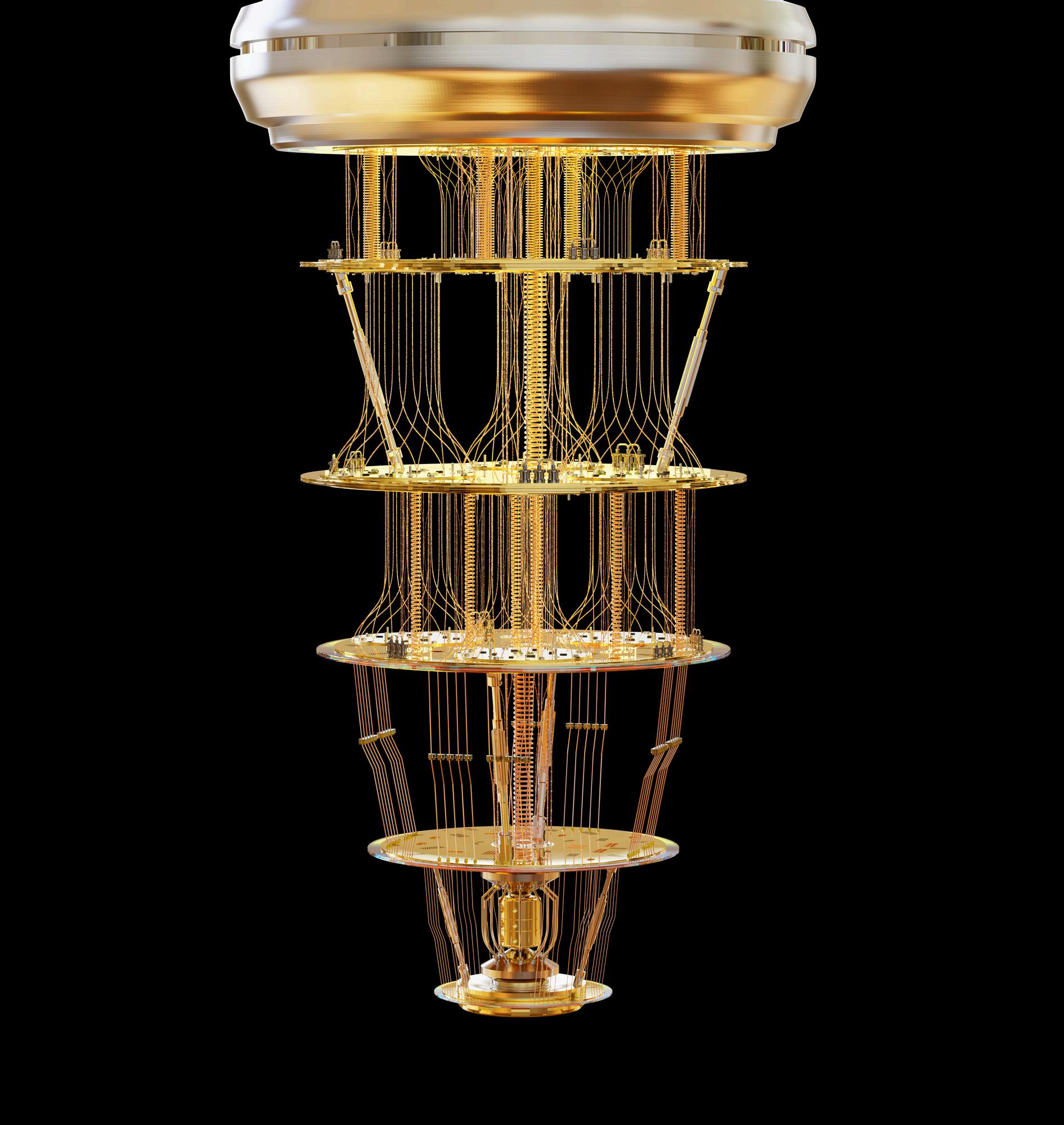

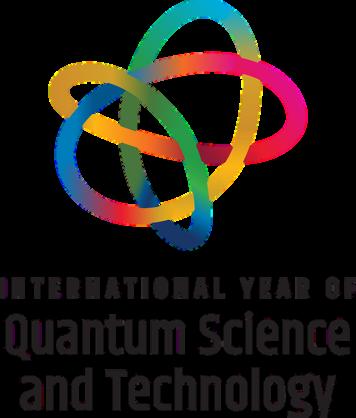








For more than 40 years Quantum Design (QD) has been providing technology solutions to researchers in the fields of physics, chemistry, biotechnology, materials science, and nanotechnology Established in 1982 in San Diego, California, Quantum Design is the leading commercial source for automated materials characterisation systems offering a variety of measurement capabilities

QD instruments are found in the world’s leading research institutions and have become the reference standard for a variety of magnetic and physical property measurements Quantum Design instruments are cited in, and provide the data for, more scientific publications than any other instrument in the fields of magnetics and materials characterisation This means that each year, literally hundreds of scientific publications, advancing the science of materials, use data generated from QD instruments
Contact us here at Quantum Design UK and Ireland to discuss your requirements



Montana Instruments manufactures high-precision electrical, optical, and cryogenic products for quantum computing, quantum education, quantum networking, and quantum materials research. Montana Instruments provides essential cryogenic tools for quantum pioneers.
Montana Instruments is a privately owned company with 38 employees, located in Bozeman, Montana, USA.

Supporting advanced scientific research, Lake Shore is a leading global innovator in measurement and control solutions. Leading researchers around the world trust Lake Shore for measurement and control solutions that drive the discovery and development of new materials for tomorrow’s technologies. Since 1968 Lake Shore has grown its product solutions to keep pace with evolving interests in scientific exploration, from the physics lab to deep space.


A MAGAZINE FROM QUANTUM DESIGN UK AND IRELAND Contents
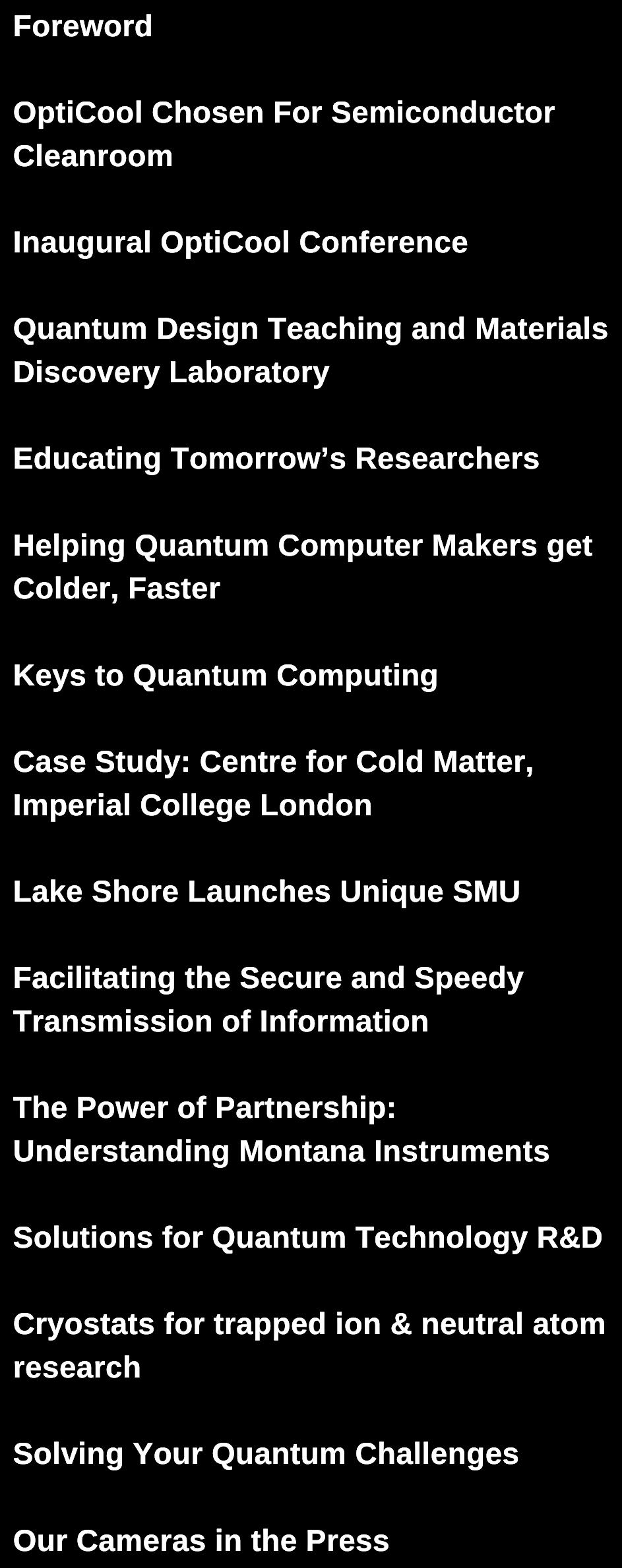

Keys to Quantum Cryogenics
THE POWER OF PARTNERSHIP: UNDERSTANDING MONTANA INSTRUMENTS
Quantum Computing Helping quantum computer makers get colder, faster.
Quantum Design Teaching and Materials Discovery Laboratory
Quantum Design holds Inaugural OptiCool Conference and User Meeting in Chicago

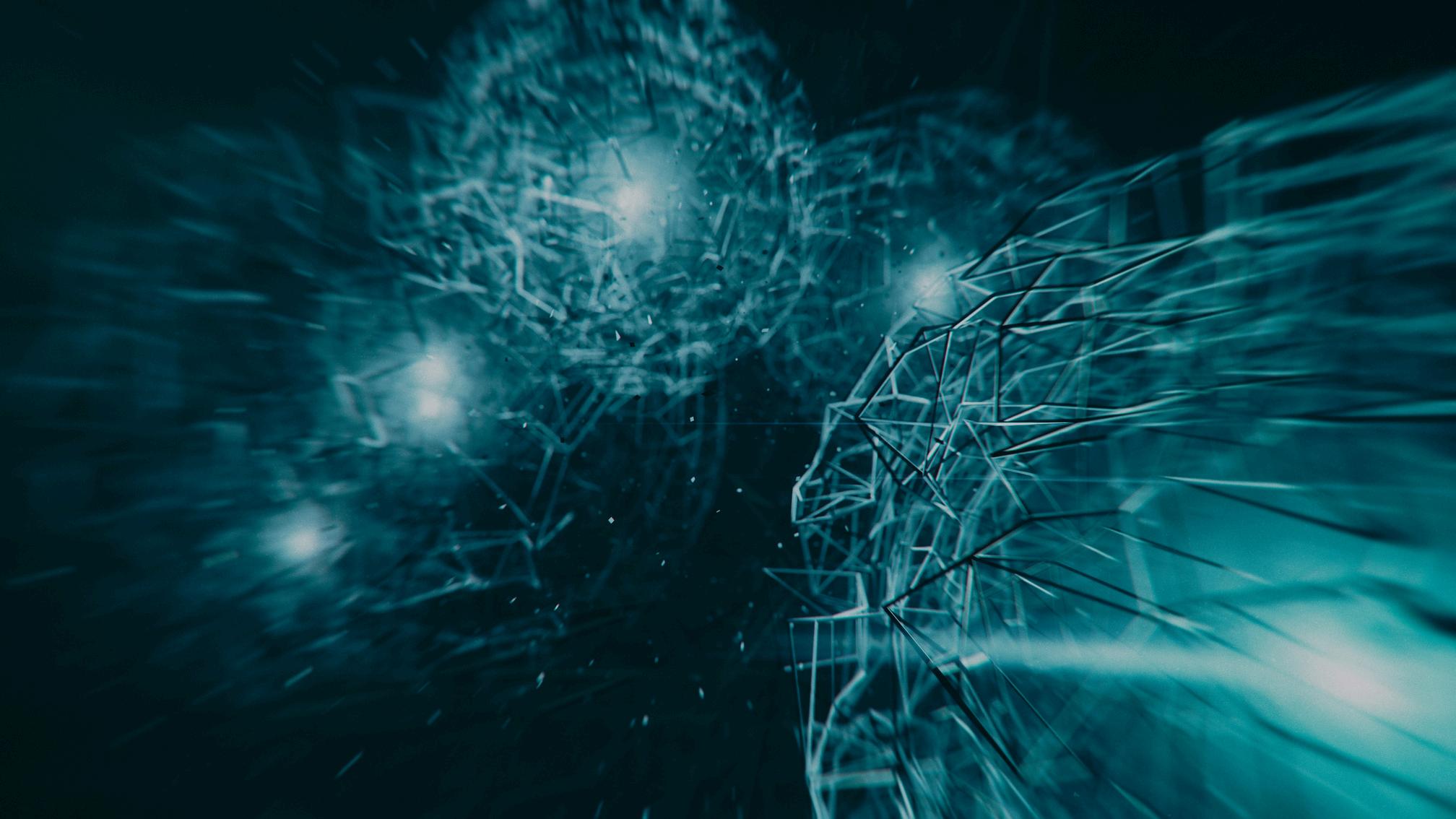
For more than 40 years Quantum Design (QD) has been providing technology solutions to researchers in the fields of physics, chemistry, biotechnology, materials science, and nanotechnology.
Established in 1982 in San Diego, California, Quantum Design is the leading commercial source for automated materials characterisation systems offering a variety of measurement capabilities.
QDUKI is proud to be a part of the expanding landscape of quantum technology commercialisation and industrial advancement in the UK, where approximately half of all quantum businesses in Europe call home.
We are confident that our suite of cryogenic instrumentation represents the ideal solution for advancing research into new materials and driving innovation in optical quantum computing and QUBIT technology.
In this inaugural issue of Quantum Magazine, we showcase the systems, solutions, and strategic initiatives that position our company at the forefront of the quantum revolution. Explore compelling case studies, insightful interviews, and valuable information as we embrace the future of quantum technology.


Dr. Shayz Ikram TECHNICAL DIRECTOR



Roman Potjan is a pHd student at the Fraunhofer IPMS for the Center Nanoelectronic Technologies (CNT) His particular areas of interest are Materials Science, Superconducting Quantum Technologies, and 300 mm Semiconductor Technology.
Roman explains, “Right now we are contacting super conducting nanostructures with microbes in-situ using nanopositioners, working at cryogenic temperatures. An additional microscope that we added later is contacting chips inside of the chamber.”
THIS TOOL IS A VERY CRUCIAL ADDITION TO OUR EXTENDING RESEARCH ENDEAVOURS IN THE FIELDS OF CRYOGENICS AND QUANTUM TECHNOLOGIES, WITH APPLICATIONS SUCH AS QUANTUM COMPUTING.”


The OptiCool optical cryostat is a cryogenfree system with automated software to control temperature and magnetic field. At the push of a button you can change your sample temperature from 1 7 K to 350 K, with or without an applied magnetic field A generous 89 mm diameter by 84 mm tall sample volume provides exciting possibilities in experiment design.


September 9 - 10, 2024
On September 9-10, Quantum Design, in partnership with The Chicago Quantum Exchange and Lake Shore Cryotronics, hosted the first-ever "Magneto-Optics in Quantum Materials Conference" which served as the inaugural OptiCool user meeting at the University of Chicago.
The two-day event featured cuttingedge advancements in magnetooptics, ultrafast phenomena in magnetic fields, and scanning probe nanoscopy in quantum materials.
This conference originated from an idea proposed by Prof. Mengkun Liu from the State University of New York at Stony Brook back in December 2023. Prof. Liu is a leader in low-temperature nanoscopy and a committed OptiCool user; and was instrumental in shaping the event We are deeply thankful for his exceptional leadership.
We also extend our gratitude to our distinguished scientific committee Professors David Awschalom (University of Chicago), Dmitri Basov (Columbia University), and Richard Averitt (UCSD) whose expertise and guidance were vital to the conference's success Special recognition goes to Andrea Jett, David Shimomura, Dr. Kate Timmerman, Dr. Rick Hapanowicz, Jesse Gallop, and Michelle Lehman for their hard work in making this event possible


One of the conference highlights was the research laboratory tours at the Pritzker School of Molecular Engineering, including a visit to the OptiCool Research Laboratory a state-of-theart facility dedicated to advancing quantum materials research and education This laboratory, part of a collaboration between the Quantum Design Discovery Teaching Laboratory and the Chicago Quantum Exchange, promises to make a significant impact on the future generation of quantum researchers We are excited to see this partnership come to life and thank Prof Awschalom for spearheading the transition of quantum information science from the lab to practical, real-world applications


With over fifty scientific publications using data from the OptiCool measurement system, the conference provided ample opportunities for in-depth discussions Attendees engaged with the presentations, networked with peers, and shared their latest unpublished results for the first time More than just a knowledgesharing platform, the event aimed to inspire fresh ideas, foster collaborations, and drive innovation in the field

To further fuel innovation, the Quantum Design Q-Works team, composed of Dr. Randy Black, Dinesh Martien, and Dr. William Neils, the brilliant minds behind the OptiCool system, was present at the conference and eager to gather feedback for future developments, including new customisations, measurement modes, and hardware configurations.
The first day of the conference concluded with a reception, offering a fantastic opportunity for networking and for Quantum Design's CEO Greg DeGeller and VP Stefano Spagna to present Prof Mengkun Liu with a recognition prize for his pioneering research and inspiring leadership in the field of Magneto-Optics in Quantum Materials.

“THESE KINDS OF FOCUSED MEETINGS ARE MY FAVORITE. IT WAS A VERY INTERESTING TWO DAYS, AND I LOOK FORWARD TO FUTURE VERSIONS OF IT.”
Prof. Peter Armitage Johns Hopkins University
Collective excitations in a quantum magnet Elaine (Xiaoqin) Li University of Texas at Austin
The interaction of charge, spin, lattice, and orbital degrees of freedom in correlated materials often leads to diverse and unique properties. Recent research has provided fresh insights into bosonic collective excitations in these materials For example, inelastic neutron scattering has demonstrated non-trivial band topology for magnons and spin-orbit excitons in the quantum magnet CoTiO3
In this talk, I will discuss novel phonon properties in CoTiO3 resulting from strong spin-orbit coupling, substantial crystal field splitting, and trigonal distortion. Notably, the coupling between spin-orbit excitons and phonons introduces chirality to two phonon modes, leading to significant phonon magnetic moments as seen in magneto-Raman spectra. In addition, I will discuss unusually longlived zone-boundary magnons observed via two-magnon resonance Both band topology and magnetic 3 anisotropy are critical elements endowing a long lifetime to the THz magnons in the antiferromagnetic phase
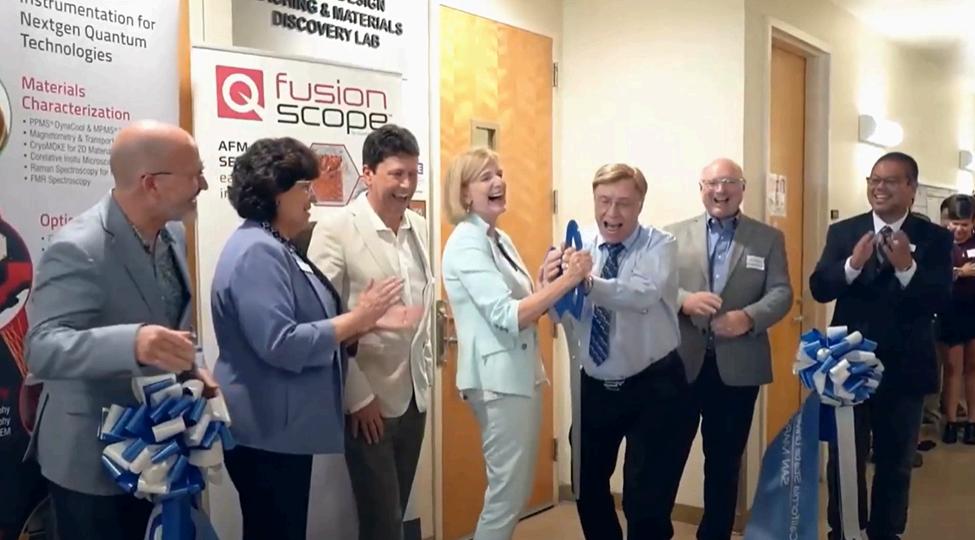
Q u an t u m D e s i g n
T e ac h i n g an d
M at e r i al s
D i s c o v e r y
L ab o r at o r y
Begunalmost10yearsago, the main goal of Quantum Design’s Education Initiative is to expand and innovate the teaching of hands-on, experimental physics in the undergraduate arena. Most often, undergraduate physics students are limited to learning theory in classrooms with laboratory experience, if any, limitedinscopetoonlyverysimple experiments.
Quantum Design knows that the scientists of tomorrow begin as the physicsstudentsoftoday.
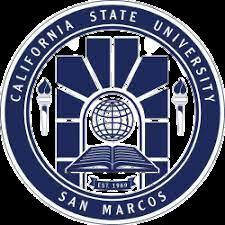
Therefore, the sooner those students become familiar with industrystandard equipment, the sooner their natural scientific curiosity and excitementcanbeawakened,andthe more comfortable they can become withthesetools.
“Quantum Design is very passionate and committed to using innovation in undergraduate laboratory education This is why, along with our industry partners and university collaborators, QDUSA has developed a teaching curriculum that can be used for this purpose.”StefanoSpagna,VPStrategy &Innovation,QDI.

In addition to providing undergraduate labs like this with instruments such as the PPMS VersaLab, Quantum Design and its Education Board of Advisors have worked together to create freely available experimental modules that can be used with the PPMS VersaLab. These modules lead students through various measurements (electrical, thermal, magnetic) so that they can become better familiar with basic materials research principles. They also provide ready-made coursework for educators who wish to incorporate thesetypesofexperimentsintheirlab classes.
“Right now, it is an important time for undergraduate students to be exposed to Quantum Information Science because of how rapidly the quantum info industry is growing. ” said Advisory Board memberDr.JustinPerron,“We're starting to see a lot more positions for undergraduate levelscientistsandengineers,

“Whatwouldhappenifyoucould getastateoftheartinstrument thatresearchersaround theworldalreadyuse andputthatinan instructional laboratory?”
StephenTsui Professor CSUSM
Lake Shore Cryotronics, a leading cryogenic temperature sensor and scientific instrument manufacturer based near Columbus, Ohio was excited to be part of the celebration and co-sponsored the event. They alsoprovideddemonstrationsofsome of their newest instruments (such as the M91 FastHall™ Measurement Controller and the M81 Synchronous Source Measure system), both of which are appropriate for undergraduatephysicslaboratories

Perhaps Dr. Tsui said it best when he highlighted the importance of programs like this to the local community: “We serve our region. A little over half of the students we graduatearethefirstintheirfamilyto go to college, and roughly 80% of them stay in the region and join our local workforce Programs like this are not only serving the students and our Physics Department, but also contributing locally to the welfare of our region As one example, many of these students now work at Quantum Design, locally serving as engineers andothertechnicalstaff”

“UsingtheVersaLab preparedmetonotbe intimidatedusingother laboratoryequipment.I thinkit’simportantfor undergradstobe exposedtothistypeof equipment.”
JosefaGergorio,CSUSMAlumnaand
FinalTestEngineer,QuantumDesign).
Stefano Spagna says the Education Initiative is entering a new stage of expansion, “I am truly excited to see wherewewillgonextandalltheways we can expand this essential program to expand and improve the teaching of experimental physics in undergraduate physics programs around the country, and even in other countriesaroundtheworld”

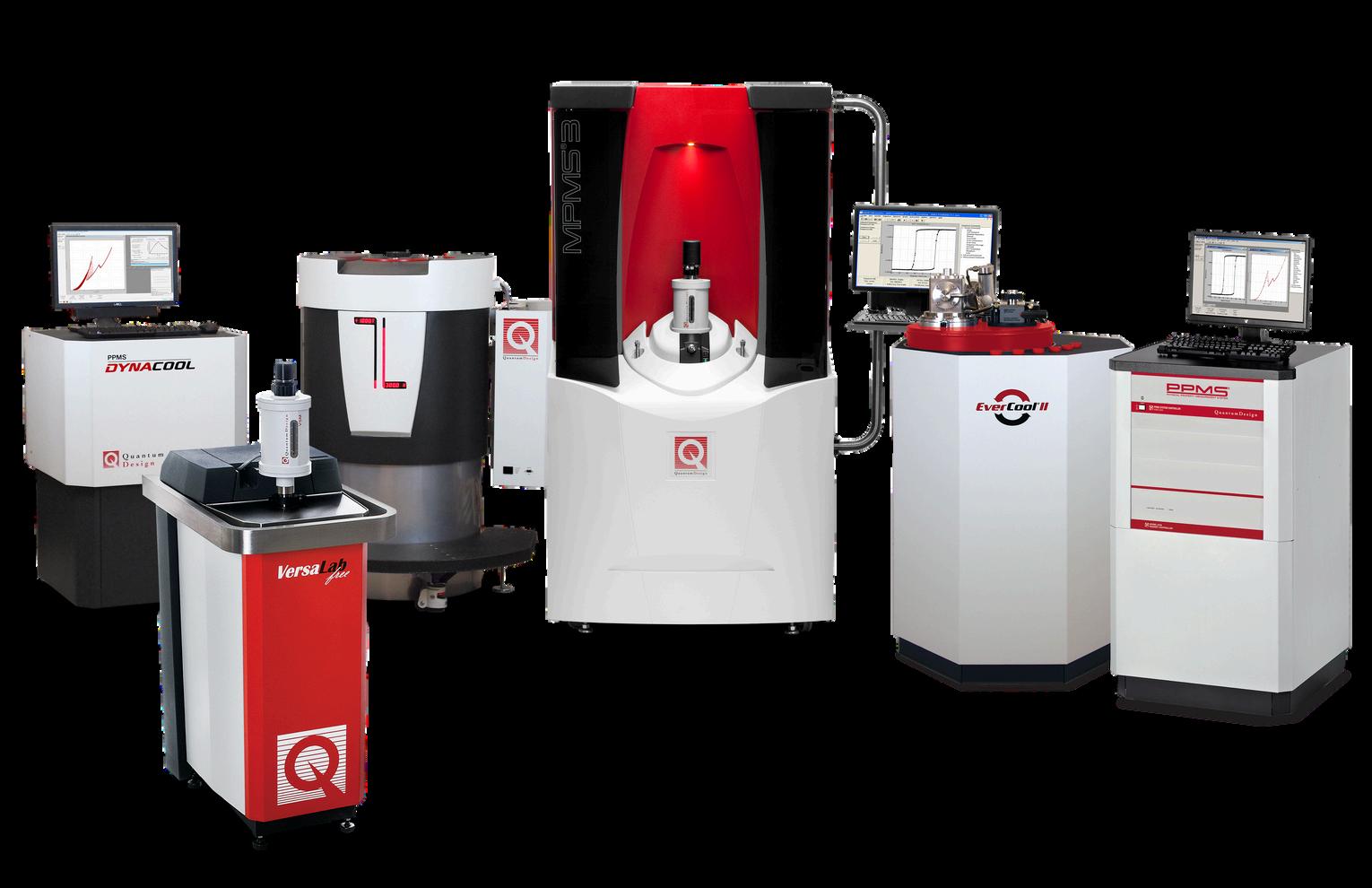
Contact us here at Quantum Design UK and Ireland to discuss your requirements
Since its inception in 1982, Quantum Design (QD) has developed and manufactured automated temperature and magnetic field testing platforms for materials characterisation.
These systems offer a variety of measurement capabilities and are in widespread use in the fields of physics, chemistry, materials science and nanotechnology. Quantum Design instruments are found in the world’s leading research institutions, and have become the reference standard for a variety of magnetic and physical property measurements.

QD INSTRUMENTS ARE CITED IN, AND PROVIDE THE DATA FOR, MORE SCIENTIFIC PUBLICATIONS THAN ANY OTHER INSTRUMENT IN THE FIELDS OF MAGNETICS AND MATERIALS CHARACTERISATION.
QD INSTRUMENTS ARE CITED IN, AND PROVIDE THE DATA FOR, MORE SCIENTIFIC PUBLICATIONS THAN ANY OTHER INSTRUMENT IN THE FIELDS OF MAGNETICS AND MATERIALS CHARACTERISATION.
Each year, literally hundreds of scientific publications, advancing the science of materials, use data generated from QD instruments.

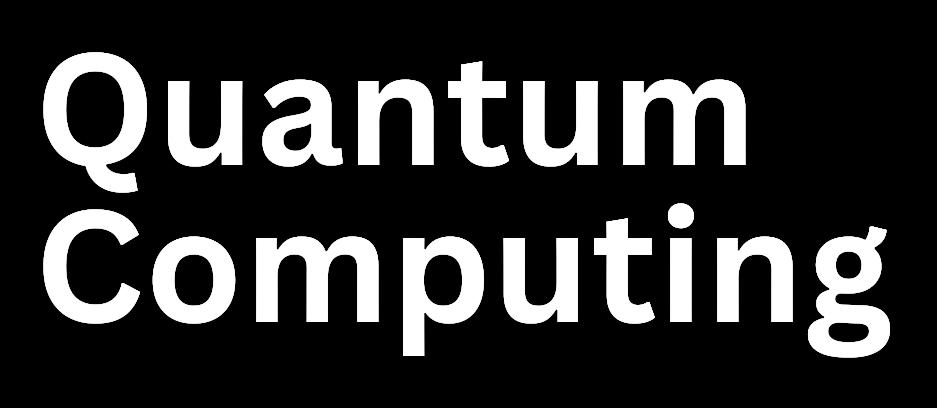
Helping quantum computer makers get colder, faster.

Talk to Dr Luke Nicholls, to learn more about Montana Instruments and your application, Email Luke or call (01372) 378822

Montana Instruments don’t make quantum computers; they enable those who do ... and will
Quantum computing promises to deliver major advances in a wide variety of fields including simulations of the natural world, virtual quantum experiments, quantum cryptography, data communication systems, and new pharmaceutical drug research and design These new and exciting research frontiers in quantum computing rely on two hallmarks of quantum physics: the superposition of states and quantum interference.
Montana Instruments has developed a line of cryogenic products to meet the needs of the quantum computing industry for research and development, production testing, and critical quantum computer infrastructure There are multiple active architectures under consideration for the realisation of a scalable quantum computer. The most promising candidates are those utilising photonics, spin/quantum dots, superconducting circuits, and trapped ions
Photonics
Spin/quantum dots
Superconducting circuits
Trapped ions
Montana Instruments has overcome the cryogenic barriers to entry for ion trap, photonic, and superconducting circuit research and development
They've done this by helping alleviate the following common experimental challenges:
Disruptions to the local sample environment such as mechanical vibrations can impart energy to the qubit states and destroy the quantum environment
Trapped ion experiments require high vacuum conditions to reduce the number of molecular collisions with trapped ions
Cryogenic conditions are required because thermal energy can excite vibrational motion that disrupts the quantum computing operations
Thermal radiation can drive undesirable internal RF transitions in trapped ions or can raise a superconducting circuit above its critical temperature
Power fluctuations in laser sources as well as RF power source instabilities perturb the QC system

Fluctuating external magnetic fields can alter atomic transitions (Zeeman effect)



A high vacuum, low vibration, and stable cryogenic environment are required to prevent any unwanted excitation of the qubit state. Superior optical access (low working distance and high numerical aperture) for spatially resolved laser excitation and high collection efficiency fluorescent readout is also necessary for trapped ions and some spin/quantum dots.
Low vibrations are key to preventing energy transfer to qubits and distortion of the quantum state.
Cryogenic environments minimise thermal excitation of qubits. <10mK temperature stability is important to minimise thermal excitation.
A low working distance objective with a high numerical aperture (0.9 NA, for example) provides a narrow excitation spot for individual trapped ions and provides high collection efficiency. Our objective is temperature controlled to virtually eliminate drift. This eliminates the need for frequent realignment and maximises data collection time.
Additional window ports may be used to laser ablate (generate the ions) or laser cool (prepare the quantum states). Our cryogenic systems can be configured with multiple side windows and a top window. In addition, the availability of larger sample spaces make it easy to address the sample from multiple incident angles.
Many electrical feedthroughs may be required to either generate the RF trapping potential or operate the superconducting circuit. Our base panels can be used to add low frequency/DC wires in addition to coaxial wires for low loss and higher frequency signal (up to approximately 20GHz). The sample space is kept uncluttered through the use of specially designed low thermal heat load cryogenic ribbon cables.
Molecular and atomic collisions can excite qubits out of their quantum state or completely knock an ion out of the trap, destroying the quantum crystal. Our integrated charcoal cryo-pumps enable high vacuum operation for months at a time.

The Montana Cryostation lies at the heart of a number of experiments in my group. The Cryo-Optic add-on allows us to perform optical spectroscopy on single organic molecules at low temperature with excellent collected photon count rates from the in-vacuum high-NA objective. The system reaches a base temperature low enough to observe atomically-narrow resonances in these molecules, making them suitable for use in quantum technology.
The automated temperature control allows us to investigate the effects of phonon-induced dephasing with ease, while the integrated nanopositioning system and sample holder – designed in collaboration with Montana Instruments and QDUK – is fully compatible with the nanophotonic devices we are investigating at low temperature. All of our experiments benefit from the low vibrations seen in the Montana Cryostation, stable coupling to nano-



-photonic waveguides to diffractionlimited confocal microscopy. The support we have received from QD-UK has been excellent – they are easily contactable should issues arise and are very open to collaborative problem solving to expedite finding a solution. Having all of this is in a closed-cycle system that does not require the purchase of expensive and increasingly rare liquid helium is the icing on the cake.”



A new module for the Lake Shore Cryotronics M81-SSM has been launched, the M81-SMU-10. This is the first SMU on the market with DC, AC and lock-in detection, optimised for characterising nanoscale devices.
The source measure unit (SMU10) is the latest module addition to the MeasureReady™ M81SSM synchronous source measure system It is specifically designed to handle the delicate nature of nano and ultra- cold samples with exceptionally low source noise and high measurement sensitivity. The SMU-10 offers both DC and AC capabilities and an integrated lock-in, providing a comprehensive suite of measurements tailored to advanced research applications.

The new SMU-10 makes highly sensitive, selective AC detection technology used in research labs conveniently available to semiconductor design and test engineers. Using the familiar four-instrumentsin-one SMU format, they can easily make extremely sensitive, low-noise measurements”
Chuck Cimino, Senior Product Manager for Lake Shore
find out more
When testing multi-terminal devices in a cryogenic probe station, use the M81SSM with SMU-10 modules to apply voltage or current to the DUT and measure the corresponding current or voltage. The SMU’s topology reduces the number of probe arms by half, significantly minimising thermal impact. Set compliance limits to protect the DUT from accidental overloads.
The M81-SSM’s advanced resistance mode compensates for phase shifts caused by parasitic capacitance in cryogenic environments, ensuring more accurate resistance measurements This technique reduces errors significantly, improving measurement accuracy.
Ideal for high-current devices. The Sense-HI and Sense-LO leads enable 4wire measurements for built-in device voltage monitoring while sourcing currents. Synchronised sampling Patented MeasureSync™ technology ensures perfect timing coordination for AC or DC measurements across multiple SMU-10 modules, eliminating data misalignment errors
The SMU-10 module is useful in any low-power test applications that have challenging signal-to-noise ratios. Primary applications include I-V characterisation of transistors used in specialised sensors, nanoelectromechanical systems (NEMS), quantum computer readout electronics, and emerging sand integrated circuit nanoscale semiconductor-based devices

The SMU has got this convenience argument … whether you want to put a voltage or a current –measure voltage – it’s simply a programming choice. You don’t have to move wires around. You don’t have to get another instrument.”
Chuck Cimino, Senior Product Manager Lake Shore

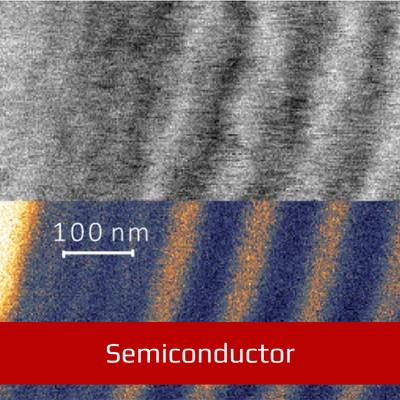
The SMU-10, which occupies two channels (one for sourcing and one for measuring), exemplifies this flexibility. While it can operate on a single source channel, that setup limits its measurement functionality. The M81SSM simplifies complex instrumentation setups by integrating DC/AC sourcing, DC/AC measuring, resistance measurements, and lock-in capabilities into a single, ultra low-noise solution
We’re about one-tenth of the noise [of competing instruments],” notes Cimino, emphasising the noise performance improvements in comparison to other SMUs.”
Chuck Cimino, Senior Product Manager for Lake Shore

Minimise thermal impact by using SMU-10 modules with a probe station. In this example, the orange wire is the source, the light blue wire is the drain, the dark blue wire is the gate, and the black wire is the ground.


The MeasureReady™ M81-SSM is a unique instrument architecture that provides a reliable and streamlined approach for advanced measurement applications. Its modular design allows multiple compact modules to connect to the main M81-SSM instrument, enabling a variety of source and measure configurations Available with two, four, or six channels, the M81-SSM dedicates half of its channels to measure modules and the other half to source modules


The development of quantum networking promises multiple applications - quantum processor linking, secure communication, and connected arrays of entangled instruments - for human connection The technology relies on the ability to send qubits across a network of quantum devices that are physically separated Research in the field assures the scaling of computing power, secure encryption, and the most precise instrumentation to date


Montana Instruments has developed a line of cryogenic products to meet the needs of quantum networking researchers and industry pioneers. Challenges in the field arise from single photon emission and detection, increasing transmission distances between nodes, and maintaining quantum memories Several technologies are forging ahead with promising results, including diamond NV centers, spin/quantum dots, trapped atoms, and trapped ions.


From stand-alone laboratory experiments to expansive network builds, Montana Instruments has the products and manufacturing expertise to support demanding requirements. Leverage our cryogenics to aid in:
Integration of high NA optics with increased collection efficiency and vibrational stability, helping to reduce excitation powers, minimise scattering, and maximise measurement sensitivity
Cryogenic temperatures and thermal stability required for superconducting nanowire single photon detectors (SNSPDs) to increase detection efficiency, reduce dark noise, and improve count rate
Achieving cryogenic conditions required due to thermal energy that excites vibrational motion that disrupts the quantum computing operations
Reducing thermal radiation that can drive undesirable internal RF transitions in trapped ions or can raise a superconducting circuit above its critical temperature
Minimising power fluctuations in laser sources as well as RF power source instabilities that perturb the QC system
Fluctuating external magnetic fields that can alter atomic transitions (Zeeman effect)


A high vacuum, low vibration, and stable cryogenic environment are required to prevent any unwanted excitation of the qubit state. Superior optical access (low working distance and high numerical aperture) for spatially resolved laser excitation and high collection efficiency fluorescent readout is also necessary for trapped ions and some spin/quantum dots.
Low vibrations are key to preventing energy transfer to qubits and distortion of the quantum state
Cryogenic environments minimise thermal excitation of qubits <10mK temperature stability is important to minimise thermal excitation.
A low working distance objective with a high numerical aperture (0.9 NA, for example) provides a narrow excitation spot for individual trapped ions and provides high collection efficiency Our objective is temperature controlled to minimise drift, which results in maximum data collection time and minimal experimental setup/alignment.

Additional window ports may be used to laser ablate (generate the ions) or laser cool (prepare the quantum states). Our cryogenic systems can be configured with multiple side windows and a top window. In addition, the availability of larger sample spaces make it easy to address the sample from multiple incident angles
Many electrical feedthroughs may be required to either generate the RF trapping potential or operate the superconducting circuit. Our base panels can be used to add low frequency/DC wires in addition to coaxial wires for low loss and higher frequency signal (up to approximately 20GHz). The sample space is kept uncluttered through the use of specially designed low thermal heat load cryogenic ribbon cables.

Molecular and atomic collisions can excite qubits out of their quantum state or completely knock an ion out of the trap, destroying the quantum crystal Our integrated charcoal cryo-pumps enable high vacuum operation for months at a time




Since 2010, Montana Instruments has worked with hundredsofcategorypioneerstobuildconfigurable cryostats that are simple to set up and compatible withfuturesystemneeds.MontanaInstrumentshas produced 10 patents to-date for cryogenic technologies that free researchers to focus on scienceinsteadofjustequipment.



Growing up as a fifth-generation Montanan, Luke Mauritsen dreamed of starting a business.
After graduating from Montana State University, his first job was developing cryogenic technologies for a new application originated by MSU During this time, he experienced many of the challenges of scientific work at low temperatures. These experiences led him to wonder if he could impact more scientists by solving these problems and re-inventing the optical cryostat.

In 2008, Luke confided in Mike Simmonds, who had become a mentor, that he intended to start anewcompany Mikeresponded,
“Well, actually my business partner Ron Sager has been asking about you. The company we started 25 years ago, Quantum Design, recently set up a worldwide distribution network for scientific instruments which we’d like to fill with new products. In fact, you can start here in my shop and I’ll help you.”
Mike Simmonds
With startup money and the foundational mentorship of Ron and Mike, Montana Instruments was given a chance to venture into the unknown, an opportunity towriteabrilliantstoryofitsown.
The first months were immersed in listening to potential customers talk about what they wished they could do and understanding their diverse challenges at low temperatures. This led to an exciting new design, and the idea of "Cold Science MadeSimple"wasborn
From there - and with the support of many faithful customers and innovative partners over the yearsMontana Instruments Corporationhasneverlooked back.

Today,MontanaInstrumentssitsat thetablewithkeynationaladvisors andmajordecisionmakersfromall overtheUS tohelpshapethe futureofcryogenictechnologiesin thequantumworld.
Foundingmembersofthe QuantumEconomic DevelopmentConsortium(QEDC)toenableandgrowarobust commercialquantum-based industryandassociatedsupply chainintheUnitedStates.

We innovate so that scientists can move faster toward discovery. We serve each other because that is how we best serve the customer When we serve our customers well, delighting them with a superb customer experience, we gain the privilege of expanding our influence and impact”
MontanaInstrumentsfounderLuke Mauritsen is part of the National Quantum Initiative Advisory Committee to the White House for the purpose of helping maintain US leadership in quantum information science and technology.
Most recently, Montana Instruments is partnering with Montana State University and the University of Arkansas as part of the MonArk Quantum Foundry to accelerate the development of quantum materials and devices. The foundry will assist those studying 2D materials for quantumtechnologiesbycreating tools to aid their research and infrastructure to facilitate the exchange of ideas across academiaandindustry.


Quantum technologies leverage principles from quantum mechanics, a fundamental theory in quantum physics that describes the behavior of matter and energy on the scale of atoms and subatomic particles. As we continue to harness the unique properties of quantum systems, a variety of quantum technologies have emerged, spanning computing, communications, and sensing, among others.

Quantum computing is used to solve problems that are computationally infeasible for classical computers Examples include factoring large numbers (which has implications for encryption), simulating quantum systems (useful for drug discovery and materials science), solving optimisation problems, and more
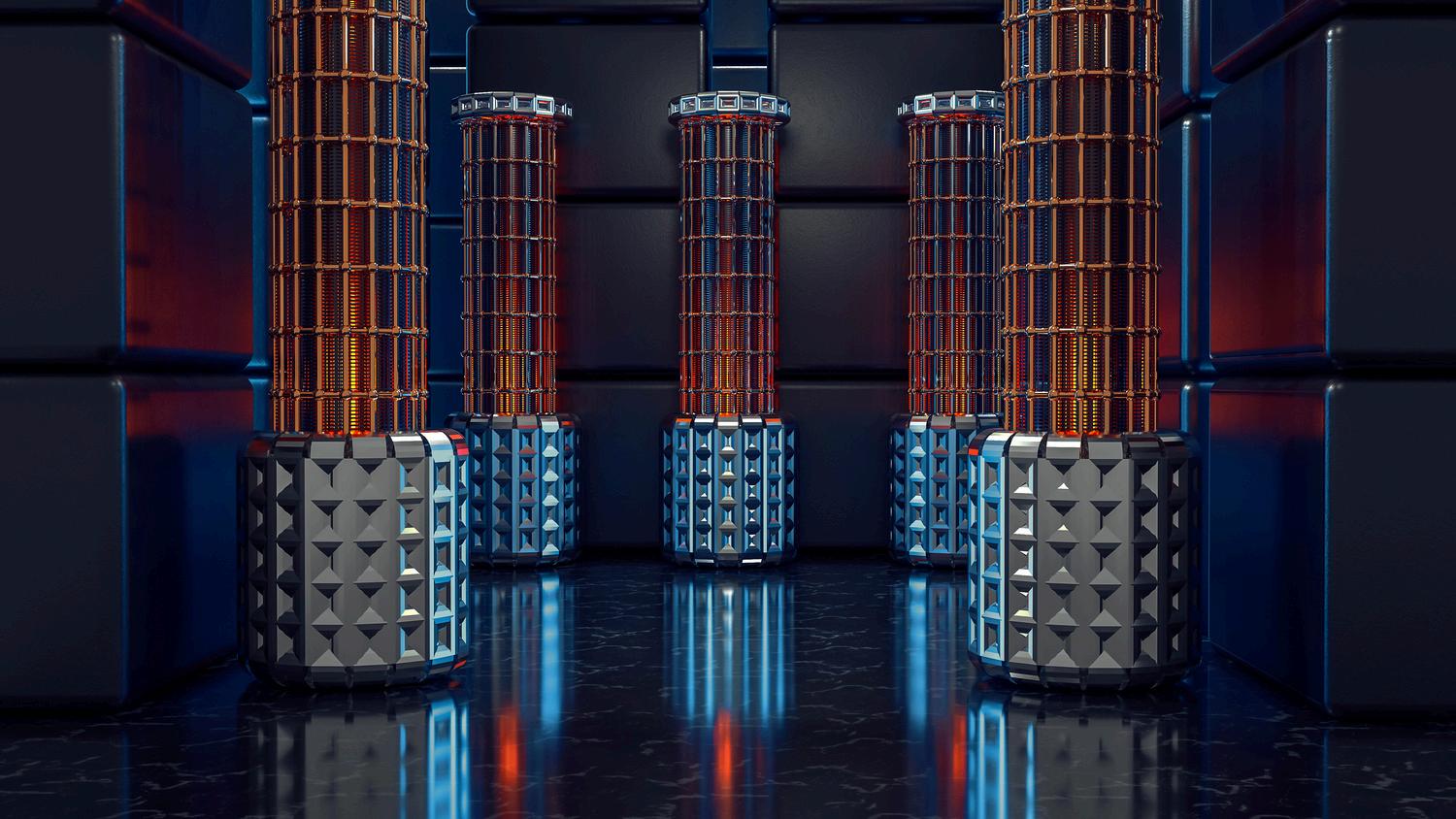

Quantum key distribution, or QKD, involves creating and distributing encryption keys in such a way that any eavesdropping can be detected Quantum secure direct communication, or QSDC, sends information directly without the need to generate and distribute a secret key And quantum repeaters/quantum internet extend the range of quantum communication, eventually forming a network for securely transmitting quantum information across the globe
Achieve ultra-precise measurements by harnessing quantum superposition and entanglement High-precision atomic clocks, magnetic field sensors, and gravitational wave detectors are all examples
Discovering new imaging modalities that can work under conditions where classical imaging fails. Examples include ghost imaging (where an object can be imaged without light directly interacting with it), super-resolution imaging beyond the classical diffraction limit, and quantum lidar


Simulate complex quantum systems that are difficult or impossible to study analytically or simulate classically. These simulations can include molecular interactions for drug discovery, studying quantum phase transitions, and understanding hightemperature superconductors
Creating a network where quantum information is processed and exchanged, paving the way for a quantum internet. Parts of doing this include remote quantum computing tasks, distributed quantum sensing, and interconnecting quantum computers for more power




Precisely engineered LHe and LN2 cryostats and cryogen-free cryostats optimised for trapped ion and neutral atom quantum simulation experiments performed under ultra-high vacuum
PLUS...
Multi-directional optical access and short working distance options
Ideal for quantum material spectroscopy research
Can be adapted to fit the size of a UHV chamber
Low-vibration cryogen-free versions are available
Available with RF cabling and feedthroughs
Base temperatures as low as less than 4 K
Low-temperature versions highly suited for prescreening qubit device designs

Ultra-low temperature (ULT) Rox™ ruthenium oxide RTD sensors and industry-leading Cernox® thin-film RTDs
Monitors with up to 12 independent sensor channels
Model 372 AC resistance bridges for precision control of dilution refrigerators that operate at <10 mK
Controllers with up to eight inputs and four independent control outputs


Evaluating new qubit device designs at cryogenic temperatures while generating millimeter-wave signals to fully characterise electronic behaviour
Sampling I-V and C-V curves over a wide range of temperatures
Measuring microwave and electrooptical responses
Characterising magnetotransport properties in variable magnetic fields



To discuss the Lake Shore range, please contact Dr. Luke Nicholls by email or call (01372) 378822.




CryoAdvance™ is a lowvibration, cryogen-free system that allows users to access cryogenic temperatures in a 50mm (3.2K—350K) or 100mm (3.4K-350K) sample chamber. A step up from the more entrylevel CryoCore® (released in February of 2021), CryoAdvance™ achieves lower temperatures and vibrations, as well as allows for increased customisation.
The CryoAdvance™ is a 3.2k configurable, low-vibration, variable temperature environment to accelerate advances in quantum science
Whether you’re an established principal investigator studying low-temperature phenomena in materials and devices or starting up a new lab, the CryoAdvance™ provides an easily accessible, tabletop environment with an intuitive touchscreen, and fully-integrated control architecture for quick and quality experimental results. It really is designed to be a foundational piece of equipment in almost all quantum laboratories
Montana customers are changing the world through applications of quantum computing, quantum sensing, quantum networking, quantum education, quantum materials research. Montana Instruments understands the cryogenic aspects of customers’ quantum challenges. Building on over ten years of experience, CryoAdvance™ is the newest product in a growing line of cryogenic tools for quantum pioneers
Competitors may try to offer lower prices or highly-customised solutions, but no one can beat the performance, flexibility, or userfriendliness of CryoAdvance™”
Josh Doherty, VP of Engineering, Montana Instruments
If you are looking for a multi-functional platform, we suggest starting with one of our Cryostation® platforms. System engineers will work with you to select or design a configuration (sample mounting, electrical & optical access, etc.) to fit your unique needs.
“
The CryoAdvance range allows our customers to get on with their research in a wide range of applications, without the need for maintaining complex cryogenic setups. Get in contact to learn more about the range today.”
Dr. Luke Nicholls, Technical Sales Manager, Quantum Design UK and Ireland

Touchscreen user interface
Displays real-time temperature status, temperature stability, and vacuum pressure readouts
Optical + DC + RF
High optical access to the sample and ability to enable the most common techniques of sample interrogation
Modular design
Facilitates understanding of the product configuration and helps users arrive faster at a solution that fits their needs
Vibration damping
Configurable, low-vibration, variable temperature environment to accelerate time and achieve real results










Cryogenics Range
Quantum Articles

